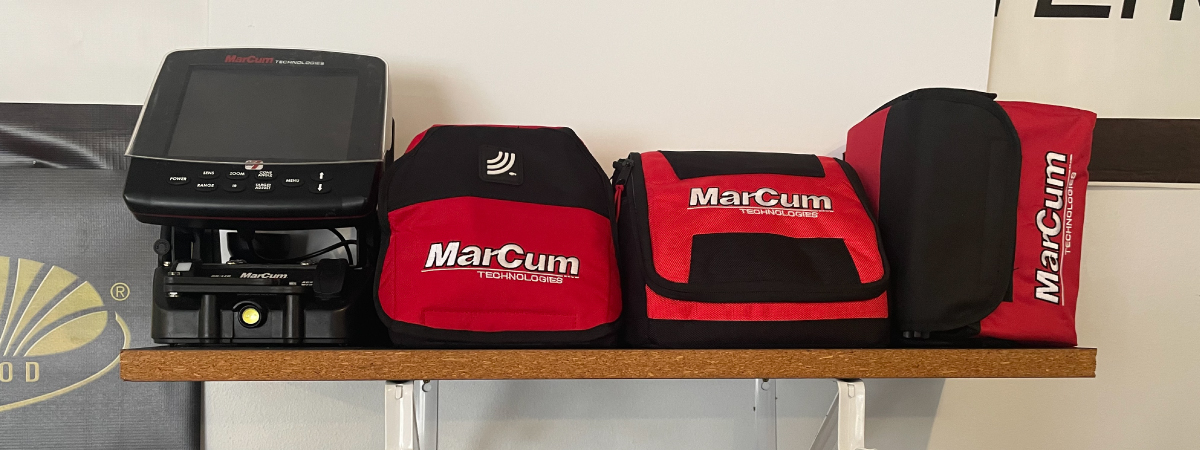Storage of Winter Electronics
and Off-season Charging
Ice fishing has come a long way over the last decade. Pretty much everything has been improved from line to fish houses. And if you are even somewhat serious about ice fishing then you have invested a lot in electronics be it an underwater camera, a flasher or a digital unit. This piece of equipment is the critical link that shows you the fish so it makes sense to take good care of it so it can bring you years of service.
Clean Up Your Electronics
There are a few things you will want to do before you put away your winter electronics for the season. Clean the unit with soap and water and make sure to dry it off properly. Check over the connectors on the back of the flasher and/or underwater camera.
For depth finders, also inspect the transducer and cable and wipe it down. Look over all the wires for cuts in the insulation or possible loose crimp connections and make any necessary repairs. Be sure and take care of them now so it will be ready to go next winter.
In order to best protect the battery, disconnect the battery from the unit to prevent any accidental power on or phantom power drain during the off-season. No battery will last if it is drained down to nothing for an extended period. Regardless of the type of battery you use, you are going to want to charge it during the off-season so it’s best to make it easily accessible.
In general, extended storage of batteries is typically defined as three to six months of storage. For ice anglers extended storage is defined as the “off-season” otherwise known as spring, summer and fall. In order to get the longest life out of your battery, you need to take care of it all year long.
Today, anglers have many more battery options then what was available just a few years ago. Each one of them has a little different personality when it comes to storing them.
Lead-acid Battery Storage
A conventional lead-acid battery can self discharge quite a bit over the summer months, so plan to charge it back up a few times during the offseason. Hook up your smart charger and charge it until the light on the charger turns green.
If your battery charger is not a color-coded smart charger then simply charge the battery for 24 hours. It’s best to keep lead-acid batteries at full charge in order to prolong the life of it. Additionally, make sure that it is stored in a location that is cooler than 85 degrees Fahrenheit. Plan on charging the battery every two to three months.

Lithium Ion Battery Storage
Lithium batteries can hold a charge much longer than a conventional battery; however it still makes sense to charge the battery sometime over the off-season. Always be sure to use the appropriate charger for the respective battery.
The battery chemistry known as Lithium-ion is found in the Marcum Lithium shuttle, Mite, Force (Scheels), Pursuit camera, Recon 5 camera and Recon 5 plus camera. It is critically important to make sure these batteries are stored above 70% capacity.
So, before you pack them away in the garage, charge them up. And then put a reminder in your phone to recharge them once again in a few months. Most of the time you will find that it has maintained its charge but you definitely want to be safe rather than sorry.
LifePO4 Battery Storage
The battery chemistry known as Lithium Iron Phosphate (LiFePO4) really has flooded the market over the last couple of years. This chemistry is found in the Marcum Brute, King and Max. Extended storage of this battery is unique. This battery should be stored at a minimum of 30-50% capacity.
It is OK to charge to 100% and store it but it is not necessary to maintain the integrity of the battery. Just do not store it for extended periods under 30% or it will affect the battery life. It is recommended to charge these batteries every three months.
Taking good care of your batteries will prolong the life of them. Always store in a dry cool environment over the summer for charging as well as storage.
For those anglers that have a boat and look forward to fishing open water, look into utilizing your electronics all year by purchasing an open water transducer for the unit. All Marcum electronics from the market leading entry-level M1 flasher to the all new MX7-GPS digital sonar have an open water transducer option.









